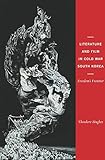Literature and Film in Cold War South Korea : Freedom's Frontier / Theodore Hughes.
Material type: TextPublisher: New York, NY : Columbia University Press, [2012]Copyright date: ©2012Description: 1 online resource (304 p.) : 19 illustrationsContent type:
TextPublisher: New York, NY : Columbia University Press, [2012]Copyright date: ©2012Description: 1 online resource (304 p.) : 19 illustrationsContent type: - 9780231157490
- 9780231500715
- Korean literature -- 20th century -- History and criticism
- Motion pictures -- Political aspects -- Korea (South)
- Motion pictures -- Political aspects -- Korea (South)
- Motion pictures -- Korea (South) -- History -- 20th century
- Motion pictures -- Korea (South) -- 20th century -- History and criticism
- Nationalism and literature -- Korea (South)
- Nationalism and literature -- Korea (South)
- Politics in literature
- Politics in motion pictures
- LITERARY CRITICISM / Asian / General
- 895.7093581 23
- PL957.5.P64 H64 2012
- PL957.5.P64 H64 2014
- online - DeGruyter
- Issued also in print.
| Item type | Current library | Call number | URL | Status | Notes | Barcode | |
|---|---|---|---|---|---|---|---|
 eBook
eBook
|
Biblioteca "Angelicum" Pont. Univ. S.Tommaso d'Aquino Nuvola online | online - DeGruyter (Browse shelf(Opens below)) | Online access | Not for loan (Accesso limitato) | Accesso per gli utenti autorizzati / Access for authorized users | (dgr)9780231500715 |
Frontmatter -- Contents -- LIST OF ILLUSTRATIONS -- ACKNOWLEDGMENTS -- Introduction -- 1. Visuality and the Colonial Modern: The Technics of Proletarian Culture, Nativism, Modernism, and Mobilization -- 2. Visible and Invisible States: Liberation, Occupation, Division -- 3. Ambivalent Anticommunism: The Politics of Despair and the Erotics of Language -- 4. Development as Devolution: Overcoming Communism and the "Land of Excrement" Incident -- 5. Return to the Colonial Present: Translation, Collaboration, Pan-Asianism -- Postscript -- Notes -- Selected Bibliography -- Index
restricted access online access with authorization star
http://purl.org/coar/access_right/c_16ec
Korean writers and filmmakers crossed literary and visual cultures in multilayered ways under Japanese colonial rule (1910-1945). Taking advantage of new modes and media that emerged in the early twentieth century, these artists sought subtle strategies for representing the realities of colonialism and global modernity. Theodore Hughes begins by unpacking the relations among literature, film, and art in Korea's colonial period, paying particular attention to the emerging proletarian movement, literary modernism, nativism, and wartime mobilization. He then demonstrates how these developments informed the efforts of post-1945 writers and filmmakers as they confronted the aftershocks of colonialism and the formation of separate regimes in North and South Korea. Hughes puts neglected Korean literary texts, art, and film into conversation with studies on Japanese imperialism and Korea's colonial history. At the same time, he locates post-1945 South Korean cultural production within the transnational circulation of texts, ideas, and images that took place in the first three decades of the Cold War. The incorporation of the Korean Peninsula into the global Cold War order, Hughes argues, must be understood through the politics of the visual. In Literature and Film in Cold War South Korea, he identifies ways of seeing that are central to the organization of a postcolonial culture of division, authoritarianism, and modernization.
Issued also in print.
Mode of access: Internet via World Wide Web.
In English.
Description based on online resource; title from PDF title page (publisher's Web site, viewed 02. Mrz 2022)


